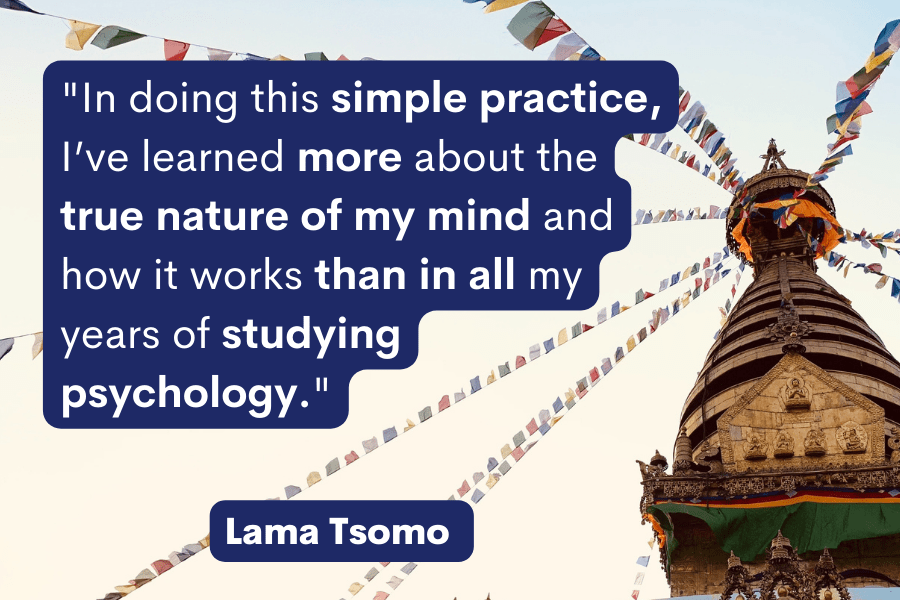A Foundational Meditation Practice
We refer to Shamata as Calm or Tranquil Abiding. It serves as the foundation for all other practices and is suitable for those just starting to meditate as well as experienced practictioners. This technique develops our power of attention and bring our coarse and subtle thoughts to a restful state. In other words, it is bringing the mind to a peaceful state then abiding in that peaceful state. This practice helps us develop basic mindfulness or awareness of our thoughts. As we cultivate habits of seeing and relating to our own inner and outer worlds in a new way, we will likely experience more ease and peace.
Enjoy the following excerpt about Shamata from Wisdom & Compassion (Starting with Yourself) by Lama Tsomo.
Tranquil Abiding
There are a few things I really like about the practice of Shamata, which translates from Sanskrit as “Tranquil Stillness,” or “Peaceful Abiding.” I like the term Tranquil Abiding, because when we Westerners start doing this practice, we tend to demand that our minds suddenly be still. We think meditation means sitting there and thinking of nothing for a half hour. The emphasis for me, though, is the tranquility of the experience. Shiney, the Tibetan term for Shamata, literally means “Tranquil Abiding.”
I also like how very restful Shamata can be, as its name implies. We tend to spend all day relating to people and things outside ourselves. Even if we aren’t actively relating to them out there, we’re thinking about them inside ourselves, in between, in our thoughts and feelings. Even at night, in our dreams, our minds are busy. Even when we finally get to sit on the beach. Even between lifetimes.
Why should I meditate?
We’ve chased after thoughts, following them with the next thoughts, following those with words and actions. . . for an eternity. Wouldn’t it be nice to take a break from making these movies all the time? To take a REAL break, and just rest? I get exhausted just at the thought of how long I’ve been ceaselessly dashing around, mentally or physically. We all need a vacation, right? Well, I take a real one every day—in my morning practice session!

And what makes it especially nice is that I get to officially do nothing and be virtuous in the bargain! No answering the phone, no thinking about work, no deciding what to do about dinner, no solving the vexing problems in my life—whew! No wonder doctors recommend forms of meditation for high blood pressure. I know some women who do it just to slow the aging process. Scientists have found that meditation boosts the immune system for many hours afterward.
And because I don’t have to do or think about anything on the outside during Shamata, I can turn the lens inward, at last. I can just sit with my mind. In doing this simple practice, I’ve learned more about the true nature of my mind and how it works than in all my years of studying psychology. For all the reasons the Buddha has taught us, we might as well know what’s really going on in there so we can go about straightening it out . . . or even just to know. (As the New Testament says, “You shall know the truth, and the truth shall make you free.”)
I don’t know about you, but I’m curious—fascinated, even. And if I run into something I want to change, I have the methods to do it. But during Tranquil Abiding, we don’t even have to direct our thoughts or come up with diagnoses and remedies. That comes in other practices. Here we just see them and remain, well, tranquilly abiding. After all this running around, reacting to outer phenomena all our lives (and countless others), we haven’t ever just sat with our minds and observed them. What better way to learn the nature of our minds? If we want to refine something, we first need to know the nature of the thing.
What if I can’t stop my thoughts during meditation?
As I’ve said, many modern people think we have to make our minds stop thoughts altogether during meditation. But the brain is, among other things, a thinking machine. It’s okay to leave the machine on and let thoughts come and go. The problem comes when we chase after these thoughts and make whole movies about them. That is the cause of our suffering. The Buddha saw exactly how that works, and I’ve shared some of his explanation. As you sit in Shamata, you’ll see those dynamics in action, for yourself.
I’ve noticed a big catch-22 with these practices. We’re using the impure mind to work on the mind. So if the tool is imperfect, won’t the results be imperfect? That’s why we begin with Shamata. We need to refine the tool. Meanwhile, we will already begin, in the process, to get to know the nature of our minds.
There’s another catch-22, and at one point I asked Rinpoche about it. Many of the practice texts say that if you do a practice perfectly, and your mind doesn’t waver for a moment, and you perceive everything in just the right, enlightened way, you can reach enlightenment by doing that practice. But if I could do the practice that way, I’d already be enlightened, and I wouldn’t need to do the practice! I pointed this out to Rinpoche, who smiled, knowing all about this, and said, “We keep on doing the practice, and little by little, it will distill our minds so that we will reach the goal after all.”
There’s yet another important reason for doing Tranquil Abiding. I think we’d all like to be better able to focus our minds on something and have it stay there. We can all do it sometimes, for a short time, but what if your mind became more dependably really peaceful and stable? I’m not talking about sinking into a stupor; quite the contrary. When we’re doing good Shamata, our minds are resting in their true state, which is bright, clear, and vivid. Wouldn’t that be a nice way to start or end the day—resting in clear, vivid awareness?
I’ve always wanted to fully experience a beautiful moment, like the sun painting the clouds with pastel light at sunset. But my mind was so constantly lost in its movies that I could never be fully there; now I can. Of course the sunset is fully available to you. With some practice at this technique you can fully be there for it too.
When we do Shamata long-term, our minds become more supple, even as they become more stable. This is not a rigid practice; it’s a very gentle one. It wouldn’t be very restful if it were rigid, would it? Experts who have done a lot of this and other practices for years find that they need very little sleep. It seems that the rejuvenating effects of such practices are more efficient than normal sleep. Who wouldn’t like that fringe benefit?
Yet another reason to do Shamata—and this one is essential—is that without that ability to put our mind on something and have it stay there, how can we get any serious benefit from the other practices? If our minds can’t stay on the mantra or the visualization, no matter how brilliantly the practice is engineered, it can’t do us much good. That’s why, even though this is the main practice of Theravada (School of the Elders), we also begin with this practice in Vajrayana. As you can probably see, it’s foundational. Sure, we’ll go on to build the walls and the roof, but first let’s lay a good foundation so the house really serves us well.
The Actual Practice of Tranquil Abiding–A Brief Introduction
Now that you’ve brought forward your bodhicitta motivation and done the Tibetan Nose Blow, you’re in a much better frame of mind to do this practice.
How should I sit during meditation?
Now you can begin the main part. Sit with your back in that supple yet-straight position. Your pelvis is rotated slightly forward, with your lower belly hanging forward a bit. If you can sit cross-legged on a firm cushion, that’s ideal. Almost cross-legged, with one foot in front, is also good. If not, a chair with a firm seat is fine too. In that case I’d recommend a thin, small, firm cushion at the small of your back. There are lots of orthopedic back support gadgets out there that work well. You could give them a try.
What are some other options besides sitting for meditation?
Another option that I happen to be fond of, because of a hip problem, is what I call the “knees-up” position. I sometimes alternate it with the cross-legged position. Sitting on the floor on a firm cushion, you put your feet together and your knees up. You can wrap your arms around your knees and clasp your hands together for support. For this position, I like to use the gom tak, a Tibetan meditation belt. It’s a band of felt that wraps around your back as well as your knees. Generally it’s nearly four inches wide; the length depends on your size. You can buy these from some Dharma stores online (ours, for one!). Some students have simply used a very large, wide belt.
Whichever position you choose, the main point is that your back has to be straight, without strain. (This will be different in each person’s body).
Your shoulders should be back. Your hands are typically folded, one on top of the other, palms facing up, in your lap. If that gets to be hard on your shoulders (I tend to slump, so I’m in this category), you can let your hands rest farther down each leg, close to the knees. I have my palms facing down, but Rinpoche doesn’t seem to be too strict on this point.
If you’re a marionette hanging from the ceiling, with the string coming out the top/back of your head, your chin naturally comes down a bit. As a matter of fact, your jaw is slack and slightly open. Your teeth and lips don’t quite meet, and you’re breathing very gently through your mouth. (After clearing our nostrils through Lung Ro Sel, a.k.a. the Tibetan Nose Blow, we don’t want to stir the karmic winds up again!) The tip of your tongue just touches the place where your upper teeth meet the roof of your mouth.
Your eyes are in a downward gaze, only half-open. Your breath wafts in through your mouth and your belly swells as it comes in—like filling a wineskin—filling from bottom to top. On the out-breath, you reverse the process, letting the air out from top to bottom.
Learn more about Wisdom & Compassion (Starting with Yourself) HERE.
Try a guided Tranquil Abiding practice with Lama Tsomo HERE.
Excerpt, pages 29-33, from Ancient Wisdom for Our Times. Tibetan Buddhist Practice: Wisdom & Compassion (Starting with Yourself (c)2021 Lama Tsomo LLC. Published by Namchak Publishing Company LLC, USA.
